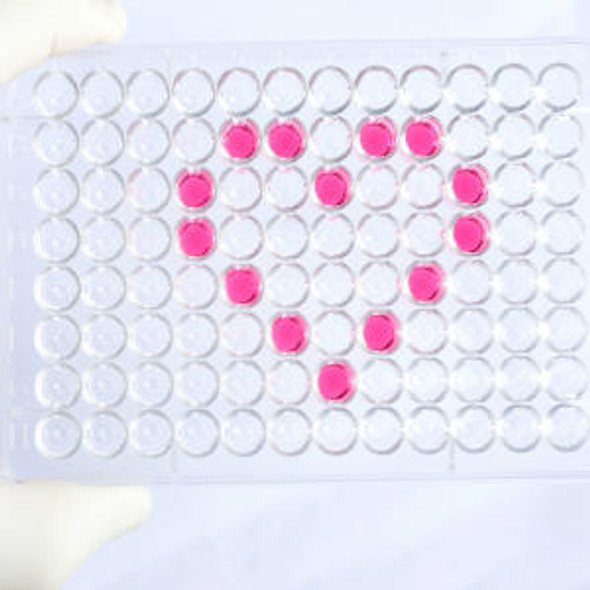Rat Thioredoxin Reductase 1 / TXNRD1 ELISA Kit (RTFI01191)
- SKU:
- RTFI01191
- Product Type:
- ELISA Kit
- Size:
- 96 Assays
- Uniprot:
- O89049
- Sensitivity:
- 0.094ng/ml
- Range:
- 0.156-10ng/ml
- ELISA Type:
- Sandwich
- Synonyms:
- TrxR1
- Reactivity:
- Rat
Description
Rat Thioredoxin Reductase 1/TXNRD1 ELISA Kit
The Rat Thioredoxin Reductase 1 (TXNRD1) ELISA Kit is specifically designed for the precise quantification of TXNRD1 levels in rat samples, including serum, plasma, and tissue homogenates. With its high sensitivity and specificity, this kit ensures accurate and reproducible results, making it a valuable tool for researchers studying the role of TXNRD1 in various biological processes.TXNRD1 is a key enzyme involved in redox regulation and cellular antioxidant defense mechanisms. It is essential for maintaining cellular homeostasis and protecting cells from oxidative damage.
Dysregulation of TXNRD1 has been implicated in various diseases, including cancer, neurodegenerative disorders, and cardiovascular diseases, highlighting its importance as a potential therapeutic target.By utilizing the Rat TXNRD1 ELISA Kit, researchers can gain valuable insights into the role of TXNRD1 in health and disease, ultimately leading to the development of novel therapeutic strategies targeting TXNRD1-related pathways.
| Product Name: | Rat TrxR1 (Thioredoxin Reductase 1) ELISA Kit |
| Product Code: | RTFI01191 |
| Size: | 96 Assays |
| Target: | Rat TrxR1 |
| Alias: | TrxR1 |
| Reactivity: | Rat |
| Detection Method: | Sandwich ELISA, Double Antibody |
| Sensitivity: | 0.094ng/ml |
| Range: | 0.156-10ng/ml |
| Storage: | 4°C for 6 months |
| Note: | For Research Use Only |
| Recovery: | Matrices listed below were spiked with certain level of Rat TrxR1 and the recovery rates were calculated by comparing the measured value to the expected amount of Rat TrxR1 in samples. | ||||||||||||||||
| |||||||||||||||||
| Linearity: | The linearity of the kit was assayed by testing samples spiked with appropriate concentration of Rat TrxR1 and their serial dilutions. The results were demonstrated by the percentage of calculated concentration to the expected. | ||||||||||||||||
| |||||||||||||||||
| Intra-Assay: | CV <8% | ||||||||||||||||
| Inter-Assay: | CV <10% |
| Uniprot: | O89049 |
| UniProt Protein Function: | TRXR1: a cytoplasmic pyridine nucleotide oxidoreductases. This protein reduces thioredoxins as well as other substrates, and plays a role in selenium metabolism and protection against oxidative stress. The functional enzyme is thought to be a homodimer which uses FAD as a cofactor. Each subunit contains a selenocysteine residue which is required for the catalytic activity. |
| UniProt Protein Details: | Protein type:EC 1.8.1.9; Nuclear receptor co-regulator; Nucleotide Metabolism - pyrimidine; Oxidoreductase Chromosomal Location of Human Ortholog: 7q13 Cellular Component: cell; cell soma; cytoplasm; cytosol; fibrillar center; mitochondrion; nucleoplasm; nucleus Molecular Function:electron transfer activity; FAD binding; mercury ion binding; NAD(P)H oxidase activity; protein homodimerization activity; selenate reductase activity; thioredoxin-disulfide reductase activity Biological Process: benzene-containing compound metabolic process; cell proliferation; cell redox homeostasis; gastrulation; hydrogen peroxide catabolic process; mesoderm formation; placenta development; protein tetramerization; response to axon injury; response to drug; response to hyperoxia; response to oxidative stress; response to oxygen radical; response to selenium ion; selenocysteine metabolic process |
| NCBI Summary: | The protein encoded by this gene belongs to the pyridine nucleotide-disulfide oxidoreductase family, and is a member of the thioredoxin (Trx) system. Three thioredoxin reductase (TrxR) isozymes are found in mammals. TrxRs are selenocysteine-containing flavoenzymes, which reduce thioredoxins, as well as other substrates, and play a key role in redox homoeostasis. This gene encodes an ubiquitously expressed, cytosolic form of TrxR, which functions as a homodimer containing FAD, and selenocysteine (Sec) at the active site. Sec is encoded by UGA codon that normally signals translation termination. The 3' UTRs of selenoprotein mRNAs contain a conserved stem-loop structure, the Sec insertion sequence (SECIS) element, which is necessary for the recognition of UGA as a Sec codon rather than as a stop signal. Alternative splicing, primarily at the 5' end, results in transcript variants encoding same or different isoforms. [provided by RefSeq, Jun 2017] |
| UniProt Code: | O89049 |
| NCBI GenInfo Identifier: | 357529586 |
| NCBI Gene ID: | 58819 |
| NCBI Accession: | O89049.5 |
| UniProt Secondary Accession: | O89049,Q5U344, Q9JKZ3, Q9JKZ4, Q9R1I3, |
| UniProt Related Accession: | O89049 |
| Molecular Weight: | 54,670 Da |
| NCBI Full Name: | Thioredoxin reductase 1, cytoplasmic |
| NCBI Synonym Full Names: | thioredoxin reductase 1 |
| NCBI Official Symbol: | Txnrd1 |
| NCBI Official Synonym Symbols: | Tr |
| NCBI Protein Information: | thioredoxin reductase 1, cytoplasmic |
| UniProt Protein Name: | Thioredoxin reductase 1, cytoplasmic |
| UniProt Synonym Protein Names: | NADPH-dependent thioredoxin reductase; Thioredoxin reductase TR1 |
| Protein Family: | Thioredoxin reductase |
| UniProt Gene Name: | Txnrd1 |
| Step | Procedure |
| 1. | Set standard, test sample and control (zero) wells on the pre-coated plate respectively, and then, record their positions. It is recommended to measure each standard and sample in duplicate. Wash plate 2 times before adding standard, sample and control (zero) wells! |
| 2. | Aliquot 0.1ml standard solutions into the standard wells. |
| 3. | Add 0.1 ml of Sample / Standard dilution buffer into the control (zero) well. |
| 4. | Add 0.1 ml of properly diluted sample ( Human serum, plasma, tissue homogenates and other biological fluids.) into test sample wells. |
| 5. | Seal the plate with a cover and incubate at 37°C for 90 min. |
| 6. | Remove the cover and discard the plate content, clap the plate on the absorbent filter papers or other absorbent material. Do NOT let the wells completely dry at any time. Wash plate X2. |
| 7. | Add 0.1 ml of Biotin- detection antibody working solution into the above wells (standard, test sample & zero wells). Add the solution at the bottom of each well without touching the side wall. |
| 8. | Seal the plate with a cover and incubate at 37°C for 60 min. |
| 9. | Remove the cover, and wash plate 3 times with Wash buffer. Let wash buffer rest in wells for 1 min between each wash. |
| 10. | Add 0.1 ml of SABC working solution into each well, cover the plate and incubate at 37°C for 30 min. |
| 11. | Remove the cover and wash plate 5 times with Wash buffer, and each time let the wash buffer stay in the wells for 1-2 min. |
| 12. | Add 90 µL of TMB substrate into each well, cover the plate and incubate at 37°C in dark within 10-20 min. (Note: This incubation time is for reference use only, the optimal time should be determined by end user.) And the shades of blue can be seen in the first 3-4 wells (with most concentrated standard solutions), the other wells show no obvious color. |
| 13. | Add 50 µL of Stop solution into each well and mix thoroughly. The color changes into yellow immediately. |
| 14. | Read the O.D. absorbance at 450 nm in a microplate reader immediately after adding the stop solution. |
When carrying out an ELISA assay it is important to prepare your samples in order to achieve the best possible results. Below we have a list of procedures for the preparation of samples for different sample types.
| Sample Type | Protocol |
| Serum: | If using serum separator tubes, allow samples to clot for 30 minutes at room temperature. Centrifuge for 10 minutes at 1,000x g. Collect the serum fraction and assay promptly or aliquot and store the samples at -80°C. Avoid multiple freeze-thaw cycles. If serum separator tubes are not being used, allow samples to clotovernight at 2-8°C. Centrifuge for 10 minutes at 1,000x g. Removeserum and assay promptly or aliquot and store the samples at-80°C. Avoid multiple freeze-thaw cycles. |
| Plasma: | Collect plasma using EDTA or heparin as an anti-coagulant. Centrifuge samples at 4°C for 15 mins at 1000 × g within 30 mins of collection. Collect the plasma fraction and assay promptly or aliquot and store the samples at -80°C. Avoid multiple freeze-thaw cycles.Note: Over haemolysed samples are not suitable for use with this kit. |
| Urine & Cerebrospinal Fluid: | Collect the urine (mid-stream) in a sterile container, centrifuge for 20 mins at 2000-3000 rpm. Remove supernatant and assay immediately. If any precipitation is detected, repeat the centrifugation step. A similar protocol can be used for cerebrospinal fluid. |
| Cell Culture Supernatant: | Collect the cell culture media by pipette, followed by centrifugation at 4°C for 20 mins at 1500 rpm. Collect the clear supernatant and assay immediately. |
| Cell Lysates: | Solubilize cells in lysis buffer and allow to sit on ice for 30 minutes. Centrifuge tubes at 14,000 x g for 5 minutes to remove insoluble material. Aliquot the supernatant into a new tube and discard the remaining whole cell extract. Quantify total protein concentration using a total protein assay. Assay immediately or aliquot and store at ≤ -20°C. |
| Tissue Homogenates: | The preparation of tissue homogenates will vary depending upon tissue type. Rinse tissue with 1X PBS to remove excess blood & homogenizein 20ml of 1X PBS (including protease inhibitors) and store overnight at ≤ -20°C. Two freeze-thaw cycles are required to break the cell membranes. To further disrupt the cell membranes you can sonicate the samples. Centrifuge homogenates for 5 mins at 5000xg. Remove the supernatant and assay immediately or aliquot and store at -20°C or-80°C. |
| Tissue Lysates: | Rinse tissue with PBS, cut into 1-2 mm pieces, and homogenize with a tissue homogenizer in PBS. Add an equal volume of RIPA buffer containing protease inhibitors and lyse tissues at room temperature for 30 minutes with gentle agitation. Centrifuge to remove debris. Quantify total protein concentration using a total protein assay. Assay immediately or aliquot and store at ≤ -20 °C. |
| Breast Milk: | Collect milk samples and centrifuge at 10,000 x g for 60 min at 4°C. Aliquot the supernatant and assay. For long term use, store samples at -80°C. Minimize freeze/thaw cycles. |





